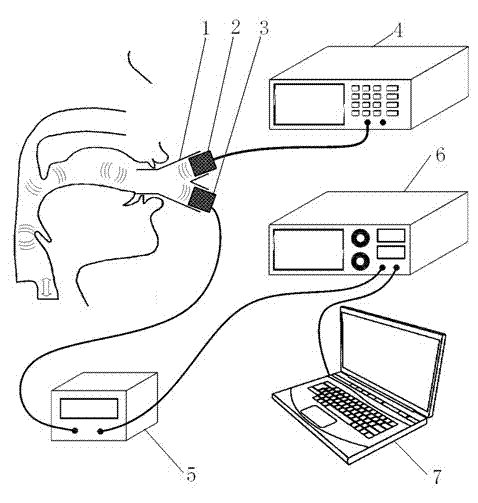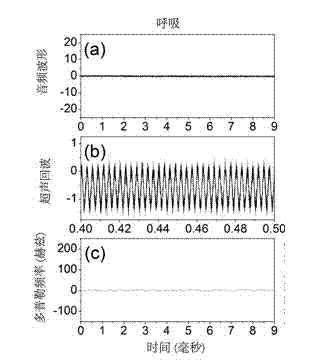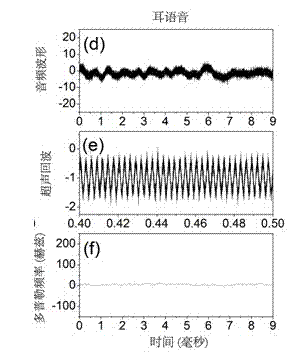Vocal-cord vibration nondestructive measurement method utilizing natural sound track ultraphonic waveguide effect
A technology of vocal cord vibration and measurement method, which is applied in the directions of ultrasonic/sonic/infrasonic diagnosis, ultrasonic/sonic/infrasonic Permian technology, ultrasonic/sonic/infrasonic image/data processing, etc., and can solve problems such as limited application range, Achieve the effects of simple measuring equipment, easy laryngeal function inspection, high safety and ease of use
- Summary
- Abstract
- Description
- Claims
- Application Information
AI Technical Summary
Problems solved by technology
Method used
Image
Examples
Embodiment 1
[0041] like figure 2 As shown, the subject is instructed to breathe into the port of the Y-shaped catheter, but not to make a sound. The signal generator generates a sinusoidal signal with a frequency of 350 kHz, and generates ultrasonic waves with a frequency of 350 kHz through an air ultrasonic transducer for transmission. Through the guidance of the Y-shaped catheter, the ultrasound is directed to the oral cavity. The ultrasonic echoes are received by another receiving air ultrasonic transducer, sampled at a sampling frequency of 100 MHz after amplification, and stored in the computer. After demodulating the ultrasonic echo signal with Hilbert transform, the Doppler frequency can be obtained. In this case of no sound, since the body belt does not vibrate, the ultrasonic reflecting surface is a static surface. The Doppler frequency value obtained by the method of the present invention is also very small, according to the formula and , it can be obtained that the spee...
Embodiment 2
[0043] like image 3 As shown in the figure, the subject is asked to speak / a / to the port of the Y-shaped catheter, and the waveform of the voice signal is as follows figure 2 (d). The signal generator generates a sinusoidal signal with a frequency of 350 kHz, and generates ultrasonic waves with a frequency of 350 kHz through an air ultrasonic transducer for transmission. Through the guidance of the Y-shaped catheter, the ultrasound is directed to the oral cavity. The ultrasonic echoes are received by another receiving air ultrasonic transducer, sampled at a sampling frequency of 100 MHz after amplification, and stored in the computer. After demodulating the ultrasonic echo signal with Hilbert transform, the Doppler frequency can be obtained. The generation of ear speech is only a non-periodic irregular speech produced by squeezing high-speed airflow through the glottis to produce audible high-speed turbulent noise, and it is an aperiodic irregular speech generated by cha...
Embodiment 3
[0045] like Figure 4 As shown in the figure, the subject was asked to face the port of the Y-shaped catheter and pronounce the vowel / a / in a normal way. Ultrasonic at 350kHz. Through the guidance of the Y-shaped catheter, the ultrasound is directed to the oral cavity. The ultrasonic echoes are received by another receiving air ultrasonic transducer, sampled at a sampling frequency of 100 MHz after amplification, and stored in the computer. After demodulating the ultrasonic echo signal with Hilbert transform, the Doppler frequency can be obtained.
[0046] The production of vowels is the result of the vibration of the body belt excitating the glottis, and the body belt produces periodic vibrations during the vocalization of vowels. Using the method of the present invention, it can be measured that, under the condition of normal vowel vocalization, the ultrasonic signal reflected from the upper surface of the body belt has obvious frequency shift. A positive Doppler freque...
PUM
 Login to View More
Login to View More Abstract
Description
Claims
Application Information
 Login to View More
Login to View More - R&D
- Intellectual Property
- Life Sciences
- Materials
- Tech Scout
- Unparalleled Data Quality
- Higher Quality Content
- 60% Fewer Hallucinations
Browse by: Latest US Patents, China's latest patents, Technical Efficacy Thesaurus, Application Domain, Technology Topic, Popular Technical Reports.
© 2025 PatSnap. All rights reserved.Legal|Privacy policy|Modern Slavery Act Transparency Statement|Sitemap|About US| Contact US: help@patsnap.com



